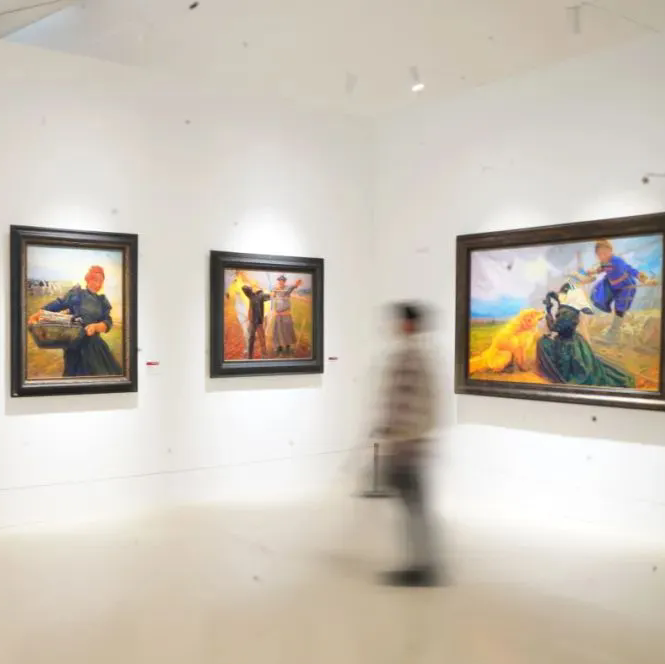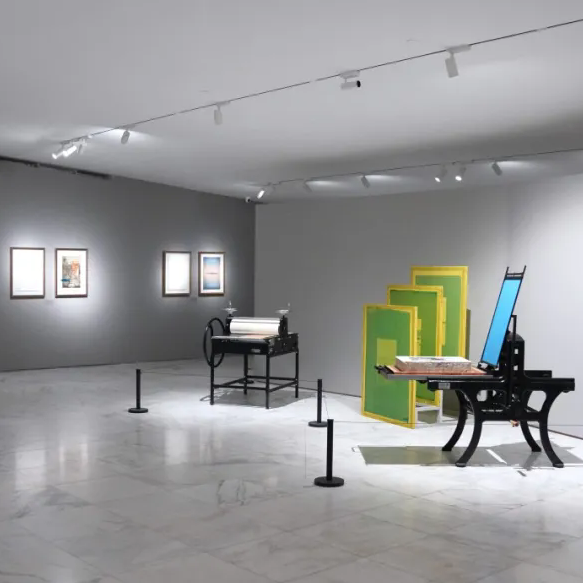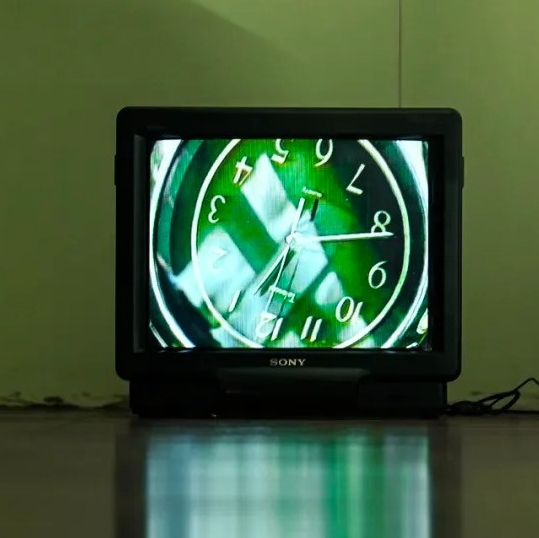 Exhibition View
Exhibition View
What does the lunar soil look like? Can lunar soil grow vegetables? Is there a code of evolution of the universe in the lunar soil? Throughout ages, human beings have been so curious about the moon that their imagination derived from the moon has left so many poems, novels, movies, art creations and so on. In addition to emotional expressions for human civilization, rational and scientific explorations of the moon have also been conducted. On December 17, 2020, 1,731-gram lunar soil samples were successfully brought back to Earth by the Chang’e-5 returner. Hereafter, scientists have conducted systematic research on the lunar soil samples and accomplished many major discoveries that were successively published in top international scientific journals. These achievements not only reflect the progress of the country’s science and technology, but also demonstrate its comprehensive national strength.
 Exhibition View
Exhibition View
While scientists have made major advances, a group of artists has also been actively involved. Invited by Professor Wei Yang from the Institute of Geology and Geophysics, Chinese Academy of Sciences (CAS), teachers and students from the School of Experimental Art, Central Academy of Fine Arts carried out a series of artistic research and creation projects based on the scientific data on the Chang’ e-5 lunar soil sample CE5C0600YJFM00402 (weight 1.5 grams, provided by China National Space Administration). Integrating technology and art and combining themes on lunar and planetary sciences, they not only assisted the research team in obtaining the clearest and most readable images of lunar soil particles in human history, but also promoted social communication by combining popular science and aesthetic education.
What does the lunar soil look like?
Lunar soil is a fine-grained (< 1 cm) fraction of the lunar regolith that covers almost the entire surface of the Moon. The formation of lunar soil is distinct from that of terrestrial soil. The terrestrial soil is produced by uniquely terrestrial processes, such as the influences of wind and water, the activities of life, etc. However, on the waterless, airless, lifeless Moon, the lunar soil results from the continuous bombardment of meteoroids and atomic particles. This process causes pulverization and ejection of rocks accompanied by mixing and melting. Lunar soil lies on the actual boundary layer between the solid Moon and space, providing critical information about both the Moon and the space environment around it. Although scientists have learned much about the physical properties and mineral and chemical compositions of the lunar soil, the general public know very little about it.
 Professor Wei Yang from the Institute of Geology and Geophysics, Chinese Academy of Sciences (CAS) introduced the exhibition.
Professor Wei Yang from the Institute of Geology and Geophysics, Chinese Academy of Sciences (CAS) introduced the exhibition. Family Portrait—The 146 “large particles” from CE5C0600YJFM00402
Family Portrait—The 146 “large particles” from CE5C0600YJFM00402
Scientists from the Institute of Geology and Geophysics, Chinese Academy of Sciences, studied the Chang'e-5 lunar soil sample (CE5C0600YJFM00402, provided by China National Space Administration) using state-of-the-art technologies. At the same time, artists from the Central Academy of Fine Arts observed and recorded the research process, artistically presented scientific data and results, and carried out sci-tech art research, creation, and aesthetic education promotion related to the lunar soil. This exhibition is the first international sci-tech art exhibition of lunar soil. With scientific and artistic visions, the joint research team presents the beauty of lunar soil and reveals the mystery of the Moon to the public.

Video showing cross-sections of CE5C0600YJFM00402 by micro-CT scanning

AR display program
Scientists from the Institute of Geology and Geophysics of the Chinese Academy of Sciences used the most advanced technology to study the lunar soil sample of Chang'e-5 (CE5C0600YJFM00402, provided by the National Space Administration). At the beginning of scientific exploration, artists from the Central Academy of Fine Arts participated in the process, observed, filmed and recorded the process and results, and presented scientific research data artistically. In the exhibition hall, seven micrographs of lunar soil particles displayed by micro spraying were displayed, and the corresponding AR display program was made. The viewer can obtain a three-dimensional lunar soil reproduction model by scanning the particle images of these cements, breccias, basalts and other particles, and can further view the cross-sectional image of each particle and its principle explanation from the perspective of scientists. At the same time, there are also a number of Galileo's lunar sketches in the exhibition hall, which are considered to be the first observation results of human exploration of the moon with telescopes. The audience can also watch the formation of the lunar soil through the small program scanning screen, and can participate in the interactive game of collecting the lunar soil blind box to become a "lunar explorer".

Although electron microscopes can easily obtain images at up to 10,000 times magnification, each image can only cover a small field of view at high magnification. In order to take backscattered electron images of the whole particles at high magnification, the research team took 64 to 400 backscattered images of individual lunar soil particles at a magnification of 2000 times, and then stitched them into a panoramic image.
Above is the first set of cross-polarized micrographs of the Chang'e-5 lunar soil particles. Opaque acicular ilmenite and amorphous glass appear dark, while other minerals, such as pyroxene, feldspar, and olivine, compete to exhibit their gorgeousness.
The simulated lunar soil sample (CLRS-1A) is low-titanium basaltic, developed by the Institute of Geochemistry, Chinese Academy of Sciences. It is made from Changbaishan basalt with grain sizes similar to Apollo lunar soils. The mineral composition is dominated by basaltic glass and contains olivine, plagioclase, pyroxene, and a small amount of ilmenite. Its chemical composition is similar to that of low-titanium basaltic lunar soil.


The simulated lunar soil sample (CLRS-1A) is low-titanium basaltic, developed by the Institute of Geochemistry, Chinese Academy of Sciences. It is made from Changbaishan basalt with grain sizes similar to Apollo lunar soils. The mineral composition is dominated by basaltic glass and contains olivine, plagioclase, pyroxene, and a small amount of ilmenite. Its chemical composition is similar to that of low-titanium basaltic lunar soil.
The Fusion of Science Education and Aesthetic Education
The moon is not only the subject of scientific research, but also the matrix that nurtures literary and artistic creation. The first itinerant exhibition is held on the campus of CAFA, opening up a new paradigm for popular science. Through interdisciplinary communication, the organizers hope to display scientific thinking and research methodology, provide opportunities and possibilities for artistic creation, and search for new areas of growth in both science and art. They hope to inspire scientific research with an artistic vision, and reset artistic temperament with scientific discoveries.

Wang Yi, a teacher from the School of Experimental Art, Central Academy of Fine Arts, guided the tour of the exhibition.
Science and art which seem to be disparate fields, have developed together since the ancient Greek and Roman times. To a large extent, the historical results of lunar observations have been recorded through artistic ways, and scientists also hope that their scientific research results can be presented and disseminated in an artistic way. Many scientists have demonstrated their extraordinary artistic talent in the process of scientific research, and artists are often invited by scientists to participate in the drawing of lunar observations. In fact, such a tradition has been passed down to this day, especially in the computer age, which has brought more possibilities for the artistic presentation of scientific achievements. Wang Yi, a teacher from the School of Experimental Art, Central Academy of Fine Arts, guided the tour of the exhibition and introduced the observation records of the artists on the research process of the lunar soil sample (CE5C0600YJFM00402), as well as science and technology art research based on lunar soil, creation and the popularization of aesthetic education.


Glove box filled with high purity nitrogen
Because the lunar soil exists in a vacuum of the lunar surface for a long time before being brought back to earth, it is easy to be oxidized or altered if it is directly exposed to the air. Therefore, scientists usually use vacuum tanks or glove boxes to preserve lunar soil samples, so as to avoid water vapor or oxygen in the air contacting the lunar soil. In the exhibition hall, we seem to restore the working scene of a scientist studying lunar soil, but replace its scientific research content. It is well known that the moon is closely related to tidal transformation. The waves formed by the tides also stimulate our visual perception, so that our ancient people constantly expressed this fleeting natural image with simple line language, thus forming a Chinese traditional painting language, such as vortex pattern, wave pattern, vertical scroll pattern, eagle claw pattern, fan pattern, loop pattern, following pattern, and on this basis, “falling flowers and flowing water”, “Seawater River Cliff” and other arts and crafts patterns with Chinese aesthetic characteristics. The sixteen glove boxes here correspond to sixteen waves of different types. When we see these colorful patterns, how can we say that it is not a description of the moon? This is the language of the waves, but also the language of the moon. It seems that the scene of scientific research has become the scene of artistic experience.

Exhibition View of“Thousands of people photograph the Moon"
“Thousands of people photograph the Moon” is a work around the Moon phase, which is the shape of the Moon’s directly sunlit portion as viewed from Earth. It can be described using the new moon, waxing crescent, first quarter, waxing gibbous, full moon, waning gibbous, last quarter, and waning crescent. The Moon phases gradually change over a synodic month (about 29.53 days) as the Moon's orbital positions around the Earth and Earth around the Sun shift. A supermoon is a full moon or a new moon that nearly coincides with perigee—the closest that the Moon comes to the Earth in its elliptic orbit—resulting in a slightly larger-than-usual apparent size of the lunar disk as viewed from the Earth.

 Exhibition View of "Lunar Balance"
Exhibition View of "Lunar Balance"
Everyone knows Armstrong’s footprints, but few people know that there was a feather on the moon. On August 2, 1971, after arriving on the moon by the step ladder, Apollo 15 Commander Dave Scott completed a free fall experiment in honor of Galileo, releasing a feather and a hammer at the same time, and two objects landed at the same time in the vacuum microgravity environment. This directly proves Galileo's proposition that under vacuum conditions, when any object moves freely at the same height of the law, the falling time is the same. This work with the idea of "object theater" originates from this famous experiment. From Galileo's hypothesis to the feathers after landing on the moon, the moon has become a weight to measure the progress of human science and technology.
 Exhibition View of "Repeating Cycle"
Exhibition View of "Repeating Cycle"
This is a creation that continues to advance with the exhibition. The hourglass made of simulated lunar soil is rotated every 10 minutes. The mechanical arm seems to play with the hourglass playfully, but it is actually adjusting its sand falling speed to ensure the consistency of time as much as possible. Our ancestors had long known to measure the world they lived in by observing the phases of the moon, so that the “moon” became our time scale. People adjust their production and life according to the changes of the month.
 Exhibition View of "The Direction of Stars"
Exhibition View of "The Direction of Stars"
Artist Chen Mingqiang found a familiar scene when he observed microscopic images of lunar soil samples brought back by Chang’e 5. He once saw sparkling crystals and textures of different shapes in Jianyang Jianzhan, an intangible cultural heritage in his hometown, like a mysterious “little star”. So he used Jianzhan ceramic mud to imitate the texture of the lunar surface, and added a small amount of lunar meteorite minerals to the Jianzhan glaze, and then used the firing skills of Jianzhan’s intangible cultural heritage to create a unique glaze texture effect. This piece, titled “The Direction of the Stars”, uses seven fired discs to form the shape of the Big Dipper, presenting seven segments of the moon’s process while expressing the exploration cycle of the moon, which is forward and full of uncertainty.
 Exhibibition View at the Science Popularization Room
Exhibibition View at the Science Popularization Room
A science popularization room is specially set up for this exhibition. During the exhibition, experts and scholars from the National Space Administration and relevant scientific research institutions of the Chinese Academy of Sciences were invited to give a series of lectures on lunar and planetary science. In ordinary times, the Science Popularization Office will display popular science images in the form of image art, including a series of popular science documentaries on lunar exploration at home and abroad, as well as observation images and science and education films formed in the process of lunar explorations in China, the United States and the former Soviet Union.

 Exhibition View at the Aesthetic Education Room
Exhibition View at the Aesthetic Education Room
In this exhibition, an aesthetic education room is also specially set up. During the exhibition, a series of aesthetic education activities themed on the moon and planets were held here. Prior to the opening of this exhibition, the creation team has used murals, picture books and other forms to carry out the spread of popular science and aesthetic education on the theme of lunar soil. In addition to displaying the existing achievements, the aesthetic education room also prepared a large number of books and exhibits related to the moon theme, such as picture albums, stereoscopic books, poems, and reprints for the audience to read and experience. At the same time, it systematically combed and displayed the development context of lunar scientific research images. We found that the lunar observation achievements in history were to a large extent recorded through artistic means, and scientists also hoped that their scientific research achievements could be presented and disseminated in an artistic way. It is in the process of scientific research that many scientists have demonstrated with their extraordinary artistic talent, and artists are often invited by scientists to participate in the drawing of lunar observation results. In fact, such a tradition has been handed down so far, especially in the computer age, which has brought more possibilities for the artistic presentation of scientific achievements.

Honored guests talked about the exhibition on scene.
Teachers, students, and art lovers from various disciplines and backgrounds are welcome to carry out experimental artistic creations based on the scientific data, materials or subjects related to the moon. The integration, innovation, and dissemination of art, science and technology can further deepen and expand. The exhibition aims to make the latest scientific discoveries accessible to the public by incorporating the artistic vision, exhibiting the friendly temperament of the hard-core scientific and technological achievements through artistic creation, and revealing the mysteries of science to the public while cultivating their perception of beauty.
Courtesy of the Organizers, edited by Yang Zhonghui and Sue/CAFA ART INFO.




























